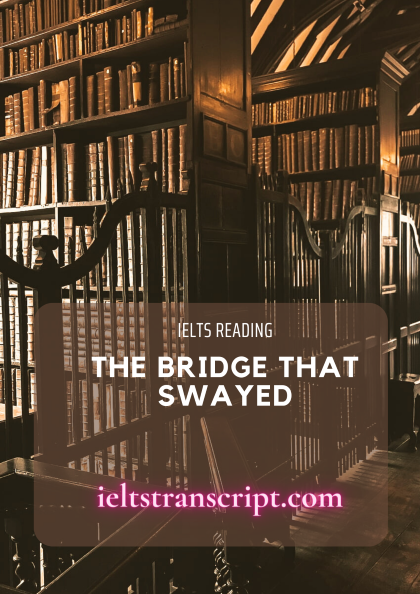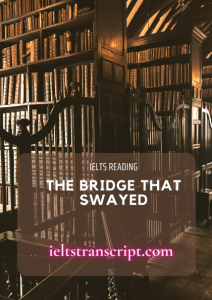- Đối với sản phẩm có giá: Sau khi chúng tôi ghi nhận thông tin đã thanh toán sản phẩm của bạn, sản phẩm sẽ được mở khóa và bạn có thể xem trực tiếp và tải tài liệu sản phẩm.
- Đối với thành viên trả phí: Bạn có thể mua và thanh toán sản phẩm với giá 0đ để tải tài liệu sản phẩm.
- Bạn có thể liên hệ với chúng tôi để được hỗ trợ mở khóa sản phẩm sớm nhất.
THE BRIDGE THAT SWAYED
- Chúng tôi chấp nhận các phương thức thanh toán sau đây: Thẻ tín dụng, thẻ ghi nợ, PayPal, chuyển khoản ngân hàng và tiền mặt.
Chúng tôi sẽ không thu thêm phí cho bất kỳ hình thức thanh toán nào.
- Nếu bạn gặp vấn đề về sản phẩm của chúng tôi trong thời gian sử dụng, vui lòng liên hệ với chúng tôi để được hỗ trợ xử lý sớm nhất nhé.
Xem trước mẫu
THE BRIDGE THAT SWAYED
When the London Millennium footbridge was opened in June 2000, it swayed alarmingly. This generated huge public interest and the bridge became known as London’s “wobbly bridge. ”
The Millennium Bridge is the first new bridge across the river Thames in London since Tower Bridge opened in 1894, and it is the first ever designed for pedestrians only. The bridge links the City of London near St Paul’s Cathedral with the Tate Modern art gallery on Bankside.
The bridge opened initially on Saturday 10th June 2000. For the opening ceremony, a crowd of over 1,000 people had assembled on the south half of the bridge with a band in front. When they started to walk across with the band playing, there was immediately an unexpectedly pronounced lateral movement of the bridge deck. “It was a fine day and the bridge was on the route of a major charity walk,” one of the pedestrians recounted what ho saw that day. “At first, it was still. Then if began to sway sideways, just slightly. Then, almost from one moment to the next, when large groups of people were crossing, the wobble intensified. Everyone had to stop walking to retain balance and sometimes to hold onto the hand rails for support.” Immediately it was decided to limit the number of people on the bridge, and the bridge was dubbed the ‘wobbly’ bridge by the media who declared it another high-profile British Millennium Project failure. In older to fully investigate and resolve the issue the decision was taken to close the bridge on 12th June 2000.
Arup, the leading member of the committee in charge of the construction of the bridge, decided to tackle the issue head on. They immediately undertook a fast-track research project to seek the cause and the cure. The embarrassed engineers found the videotape that day which showed the center span swaying about 3 inches sideways every second and the south span 2 inches every 1.25 seconds. Because there was a significant wind blowing on the opening days (force 3-4) and the bridge had been decorated with large flags, the engineers first thought that winds might be exerting excessive force on the many large flags and banners, but it was rapidly concluded that wind buffeting had not contributed significantly to vibration of the bridge. But after measurements were made in university laboratories of the effects of people? walking on swaying platforms and after large-scale experiments with crowds of pedestrians were conducted on the bridge itself, a new understanding and a new theory were developed.
The unexpected motion was the result of a natural human reaction to small lateral movements. It is well known that a suspension bridge has tendency to sway when troops march over it in lockstep, which is why troops arc required to break step when crossing such a bridge. “If we walk on a swaying surface we tend to compensate and stabilise ourselves by spreading our legs further apart but this increases the lateral push”. Pat Dallard, the engineer at Arup, says that you change the way you walk to match what the bridge is doing. It is an unconscious tendency for pedestrians to match their footsteps to the sway, thereby exacerbating it even more. “It’s rather like walking on a rolling ship deck you move one way and then the other to compensate for the roll.” The way people walk doesn’t have to match exactly the natural frequency of the bridge as in resonance the interaction is more subtle. As the bridge moves, people adjust the way they walk in their own manner. The problem is that when there are enough people on the bridge the total sideways push can overcome the bridge’s ability to absorb it. The movement becomes excessive and continues to increase until people begin to have difficulty in walking they may even have to hold on to the rails.
Professor Fujino Yozo of Tokyo University, who studied the earth-resistant Toda Bridge in Japan, believes the horizontal forces caused by walking, running or jumping could also in turn cause excessive
...CÂY CẦU LẮC LƯ
Khi cầu đi bộ Millennium London (cầu Thiên niên kỷ) được khánh thành vào tháng 6 năm 2000, nó đã bị rung lắc ở mức đáng báo động. Điều này đã tạo ra sự quan tâm lớn của công chúng và cầu được gọi là “Cây cầu lắc lư của London. ”
Cầu Millennium là cây cầu mới đầu tiên bắc qua sông Thames ở London kể từ khi Tower Bridge khánh thành vào năm 1894, và nó là cây cầu đầu tiên được thiết kế dành riêng cho người đi bộ. Cây cầu nối trung tâm thành phố London gần Nhà thờ St Paul với phòng trưng bày nghệ thuật Tate Modern ở Bankside.
Cây cầu được khánh thành vào thứ bảy ngày 10 tháng 6 năm 2000. Trong lễ khánh thành, một đám đông hơn 1.000 người đã tập trung ở nửa phía nam của cây cầu và một ban nhạc phía trước. Khi họ bắt đầu bước ngang qua ban nhạc đang chơi, ngay lập tức mặt cầu xuất hiện một chuyển động bất thường sang hai bên khá rõ rệt. “Đó là một ngày đẹp trời và cây cầu nằm trên tuyến đường của một cuộc đi bộ từ thiện lớn,” một trong những người tham gia thuật lại những gì anh đã thấy vào ngày hôm đó. “Lúc đầu, cầu đứng vững. Sau đó nó bắt đầu lắc lư sang hai bên, chỉ từng chút một. Tiếp theo, hầu như sau mỗi giây phút, khi những nhóm nhiều người đi qua, sự rung lắc ngày càng mạnh thêm. Mọi người phải dừng bước để giữ thăng bằng và đôi khi phải bám vào tay vịn”. Ngay lập tức quyết định hạn chế số lượng người trên cầu được đưa ra, và cây cầu được giới truyền thông đặt biệt danh là cây cầu ‘lắc lư’, họ cho rằng đó là một thất bại nữa trong Dự án Thiên niên kỷ đình đám của nước Anh. Để điều tra đầy đủ và khắc phục tình trạng này, quyết định đóng cửa cây cầu được đưa ra vào ngày 12 tháng 6 năm 2000.
Arup, thành viên đứng đầu ủy ban phụ trách xây dựng cây cầu, đã quyết định đối mặt để giải quyết vấn đề. Họ ngay tiến hành ngay một dự án nghiên cứu cấp tốc để tìm hiểu nguyên nhân và cách khắc phục. Các kỹ sư – những người còn đang sống trong cảm giác xấu hổ sau sự việc, tìm được đoạn video ngày hôm đó cho thấy nhịp trung tâm rung lắc sang hai bên khoảng 3 inch mỗi giây và nhịp phía nam là 2 inch sau mỗi 1,25 giây. Do có gió mạnh vào những ngày quanh thời điểm khánh thành (cấp gió 3-4) đồng thời cây cầu được trang trí bằng những lá cờ lớn, đầu tiên các kỹ sư nghĩ rằng gió có thể tác động quá mức lên nhiều lá cờ và các tấm biểu ngữ lớn, nhưng nhanh chóng sau đó họ kết luận rằng sự rung lắc do gió góp phần không đáng kể vào độ rung của cầu. Tuy vậy sau khi các phép đo được thực hiện trong phòng thí nghiệm của nhiều trường đại học về tác động của con người khi bước đi trên các nền rung lắc và sau khi có các thí nghiệm quy mô lớn với đám đông người đi bộ được tiến hành trên chính cây cầu, một cách nhìn mới và lý thuyết mới đã được phát triển.
Chuyển động ngoài mong đợi đó là kết quả của phản ứng tự nhiên ở con người đối với các chuyển động nhỏ về phía hai bên. Ai cũng biết rằng một cây cầu treo có xu hướng lắc lư khi quân đội hành quân đi đều bước qua nó, đó là lý do tại sao quân đội buộc phải ngừng bước đều khi đi qua những cầu như vậy. “Khi đi trên một bề mặt rung lắc, chúng ta có xu hướng tự bù đắp và giúp bản thân đứng vững bằng cách dang rộng hai chân ra xa nhau nhưng điều này làm tăng lực đẩy sang hai bên”. Pat Dallard, kỹ sư tại Arup cho biết mọi người thay đổi kiểu đi của họ để phù hợp với cách hoạt động của cầu. Đó là một xu hướng vô thức của người đi bộ để bước chân của họ thích ứng với sự rung lắc, do đó làm tình hình thêm trầm trọng. “Nó giống như đi bộ trên boong tàu thủy đang bị tròng trành, bạn di chuyển theo chiều này rồi đến chiều kia để bù lại phần tròng trành đó.” Cách mọi người đi lại không nhất thiết phải khớp chính xác với tần số tự nhiên của cây cầu bởi vì để tạo ra cộng hưởng, sự tác động sẽ tinh vi hơn thế. Khi cây cầu bị rung, mọi người điều chỉnh cách đi theo kiểu riêng của họ. Vấn đề là khi đạt tới một số lượng người nhất định trên cầu thì tổng lực đẩy sang mỗi bên có thể vượt quá khả năng hấp thụ của cây cầu. Dao động này trở nên quá mức và tiếp tục tăng lên cho đến khi mọi người bắt đầu khó khăn
...Để xem được đầy đủ nội dung và tải dữ liệu, bạn phải trở thành thành viên của chúng tôi và trả phí cho tài liệu (nếu có)











